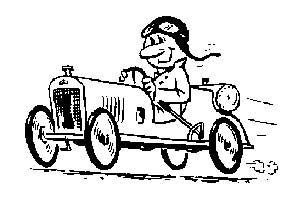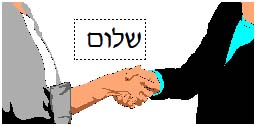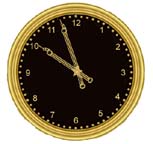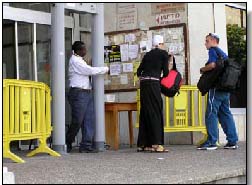A Short Preview of How Hebrew Reading and Writing Work. 1.3
(Including a quick look at the vowel symbols for those in a hurry to get started)

![]() (Hebrew goes) seog werbeH
(Hebrew goes) seog werbeH
from right to left
This book gives you the option of beginning with either the Hebrew script letters, used for writing Hebrew, or the block letters used for reading Hebrew. The "block letters" are used in printed books. For example: שלום
For Chapters One and Two you have the choice of script or block letters. After that the font will be in block letters, but you will need to know how to write in script letters. If you wish to learn the script letters at the same time as you learn the block letters look in both file options to see how to write the letters. For example:( שלום (שלום.
In Chapter Three the readings in the book will use block letters and the exercises and quizzes will require script. There are twenty-two letters in the Hebrew alphabet. All are consonants. In Ancient Hebrew the vowels of the spoken language usually were not indicated in the writing. So, each letter could be read (if we use the consonant "b" as an example) as "ba", "bih", "bo", "boo", or "beh". Talk about ambiguity! Consider this English sentence with all vowels removed: ystrdy I rd sx bks
Possible choices: rd= read / red / rode /ride /road; sx=six / sex; bks=books / bikes
In the Middle Ages an elaborate system of marks, called "nikkud" - ניקוּד in Hebrew, was developed to indicate the vowel sounds that accompany the consonants. There were many persons who needed the nikkud to help them read Hebrew. Today, some educational materials have the student use the complex system of "nikkud", as they learn to read (represented by dots and dashes), that stand for the vowel sounds.
The "nikkud" has symbols for vowel sounds like the English vowels A, E, I, O, U). Here are the fourteen (14) symbols that are used as "nikkud" when using all the symbols: (You will learn them as we proceed in Chapter One.)

6
Below is an example of the first verse of a poem by the Israeli poet Dan Pagis, with and without nikkud.
תְפִלַת שָׁאוּל הָאַחֲרוֹנָה תפלת שאול האחרונה
אֱלֹהַי, כַּבָּקָר בְּחָרִישׁ אלהי, כבקר בחריש
בֵין כָּל אֲבָנֶיךָ הָיִיתִי אֵיתָן. בין כל אבניך הייתי איתן
בְעֹל רְעָמֶיךָ הָיִיתִי מַחֲרִישׁ בעול רעמיך הייתי מחריש
וַתְּהִי שְׁתִיקָתִי לִי לְשָׂטָן. ותהי שתיקתי לי לשטן
"Nikkud" is not used much in modern Hebrew, since once you become familar with vocabulary and the Hebrew grammatical system the symbols are usually not necessary. For example, the English reader knows how to read - "yesterday I read a book" as opposed to "tomorrow I will read a book. We know from context how to pronounce the word represented by the letters "read".
In this course, the "nikkud" will be supplied when a word could be read in more than one way, providing clarification of the correct pronunciation when necessary. As the course progresses and you advance in vocabulary and grammatical mastery, less "nikkud" will be necessary.
Note that it is common to include the vowel symbols (nikkud) in songs, poetry and biblical texts. We will follow this practice.
LEARNING TO READ AND WRITE HEBREW -
קְריאה וכְתיבה 1.4![]() Use with Software Chapter 1:3 "Writing in Block
letters" (
Use with Software Chapter 1:3 "Writing in Block
letters" (
Sections 1 - 9 focus on learning to read. These sections will be covered quickly, but are crucial to your success in learning Hebrew.
The twenty-two letters of the Hebrew alphabet will not be taught in alphabetical order. Each letter will be introduced in words you will find useful as you learn to speak and write Hebrew. Pay attention to the name of each letter.
If the last syllable of a word is not accented then the accented syllable will be written in capital letters.
Let's begin with the word /shalom/ "peace", /hello/, /goodbye/. שלום

7
1.4.1 האלֶף בֵּית: ש
The first letter in /shah-lohm/ is named sheen ש . It has the sound /sh/. The vowel in the first syllable is /ah/. The first syllable is pronounced /shah/. Practice writing /shah/ a. Note the arrow in the demo marking the starting point and the direction your pencil should move.
This is
important.
You should finish your stroke so that you are moving to your left;
this will position you
for the
next letter.
![]()
Begin Here
ש
__________________________________
The most common vowel in Hebrew is the sound /ah/.
It occurs far more frequently than any other vowel. To borrow from the
terminology of computer jargon, it is the "default vowel". Assume that
the vowel is /ah/ unless another
vowel is indicated by a vowel indicator. So if you see a consonant
with no vowel indicator following it, or under it, you should add
/ah/ to the consonant in order to
form a syllable. For example, using the symbol
ש for /sh/
+ no vowel indicator following it is the way to indicate the syllable /sha/.
/shah/ =
ש. When full nikkud is used, the symbols
1.4.2 האלֶף־בֵּית: ל
The
second syllable of /shah-lohm/
שלום begins with
LA-med = /ל/
.
It has the sound /L/.
In the word /shah-lohm/ the
ל is followed by the letter
vahv ו which
is the indicator for the ![]()
1.4.3 תרְגיל כְתיבה: WRITING PRACTICE
________________________ל
________________________שלו
8
The Hebrew word שלוש , meaning three, uses the letters you have learned.
Practice writing /shah-lohsh/![]()
_________________________________שלוש
1.4.4 האלֶף בֵּית: ם
The last syllable of שלום /lohm/ ends with a special form of the letter /mehm/ - ם which must be written whenever mehm (the /m/ sound) comes at the end of a word. The mehm is one of five letters which have a special "final form" when appearing at the end of a word. Final letters can only be written at the end of a word.
Final letters (with one exception: xaf sofit) are never followed by a vowel.
Note: Hebrew does not have capital letters.![]()
Practice writing:
/mehm soh-feet/ ___________________________________________ ם
the syllable /lohm/________________________________לום
Now put the whole word together:
"hello,goodby" /shalom/_____________________שלום
1.4.5 האלֶף־בֵּית: חזרה - Review
Practice writing the following syllables:
![]()
/shoh/ _________________ שו /shohl/ ___________________שול
/lohsh/ _________________ לוש /shahm/ _________________ שם
As you will learn in section 1.5.1, when a consonant is not followed by the letters yood or vahv, you should usually supply the vowel /ah/. If there is another vowel then /ah/ we will provide it.
Remember: A the end of the word do not add any vowel; just say the sound of the consonant
/shahm/ = שם /lahm/ לם
100.00 %
Read the following: ש ש לו שו שוש לול לש
לום לוש שלום שלוש
9
1.4.6 האלֶף־בֵּית: ר The letter rehsh
 To write
ר let's imagine that we are writing our letters on the face of a clock. Begin the
ר between 10 and 11 o'clock; stop between five and six.
To write
ר let's imagine that we are writing our letters on the face of a clock. Begin the
ר between 10 and 11 o'clock; stop between five and six.
![]()
Write /rehsh/ ______________________ר
100.00 %
Read the following:
ר ר רם שר לר שור רום לו
THE BEHT with and without a dah-GEHSH -
1.4.7 האלֶף־בֵּית:
![]() Use
with Software Chapter 1:3 "Writing Block Letters"
Use
with Software Chapter 1:3 "Writing Block Letters"
beht = /b/ בּ veht = /v/ ב
Note that the letter בּ can be written בּ or ב. They are the same letter but pronounced differently depending upon their position in a word. For now, remember that at the beginning of a word it is always /b בּ At the close of a syllable or the end of a word it is /v/ ב - /rahv/ רב , /bahr/ בּר. At first we will put a dot (dagesh) in the בּ /b/ to help you remember how to pronounce it, but normally the dagesh is not printed in texts without nikkud.
Begin by writing a
/rehsh/, then add a bottom
line to make the /beht/.
![]()
___________________________ב
_________________________בּ
100.00 %

בּלם שב רב בּר בּוש בּול רוב
/la-vash/ - לבש
"wore" - what were they wearing?
הֶעָרָה
Answers
1. Yesterday I read six books
2. Yesterday I rode six bikes
3. Yesterday I read sex books